
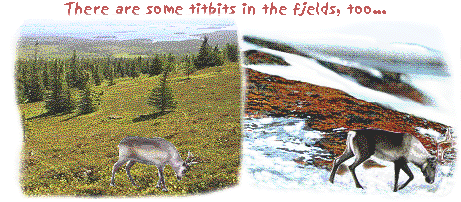
Fjelds (the second section)
Forest line Especially in the western Lapland the mountain birch (Betula pubscens var. pumila) forms the forest line. The cold and humid maritime climate of the western parts (e.g. Norway, Iceland, Greenland) favours mountain birches. In northern Russia – starting from the eastern parts of the Kola peninsula – the timber line consists of coniferous species. The upper limit of the mountain birch zone (= subalpine/orohemiarctic zone) in Finnish Lapland is about 300-600 metres above sea level, but in the continental fells of southern Norway it is clearly higher, about 1200m above the sea surface.. The border of the coniferous forest is about 50-200 meters lower (see the maps of the vegetation zones in Lapland). As an example, the timberline in the Alps is about 2000m above the sea surface and in the equator it is about 4000m. |
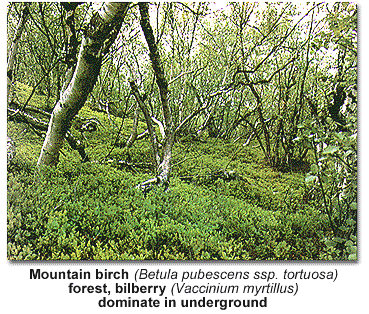
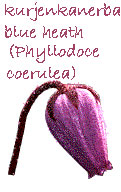
Above: The mountain birches (Betula pubescens ssp.tortuosa = var. pumila) are in this place rather tall.
In more sterile and dry places the trees are often a couple of meters long, only.
Usueally the mountain birch has meny winding trunks.
The underground parts of many northern plants are strongly developed. The underground parts
are much larger than the stems reaching above ground (e.g. Salix herbacea and Vaccinium myrtillus).
The safety deposits for e.g. rapid spring growth and flowering.
Blue heath is rather common among others in the mountainbirch forests.
(Above): An old Norway spruce (Picea abies) forest. The trees are low, growing scattered
and damaged by snow (in Finnish: tykky). More picturesabout tykky and forestline,
see: picture 2, picture 3, picture 4, picture 5, picture 6, picture7 and picture 8!
Among spruces there are here some birches, such as be similar to mountain birches
(Betula pubescens var. pumila). Anyway, there are no clean mountain birch zone
on the eastern fells of Finland, (see: picture from Rukatunturi!). - Posio, Riisitunturi fell.
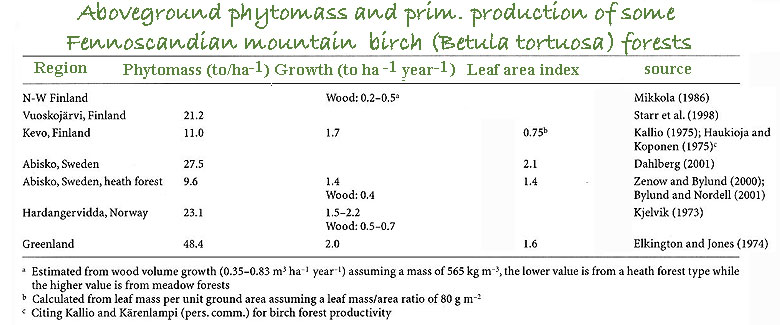
This table tell, to what extent phytomass and growth of mountainbirches fluctuate. More: growth of mountainbirch!
Mountainbirch forests are well investigated, lately. See also: geometrids and mountainbirch! and literature!
Underground parts of several northern plants are forceful developed (for example: dwarf willow, Salix herbacea and bilberry, Vaccinium myrtillus). Underground phytomass is more than aboveground fieldlayer phytomass. There are also good security stories in the undergrowth parts of plants thinking fast growth and flowering in the spring.
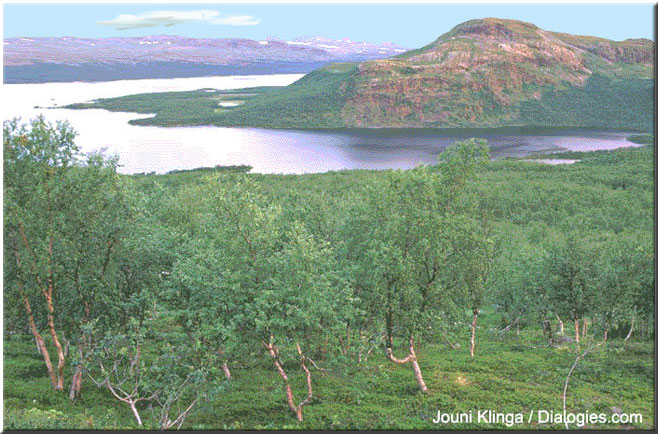
Outlook from Saanafjeld (at Kilpisjärvi). In the foreground
a mountainbirch- (Betula pubescens var. pumila) forest. Trees are branched out, curvy, but still quite big.
In the background Kilpisjärvi lake and Malla fjeld. Several rare fjeldplants thrive in Malla (since the lime).
The topplates of Malla and Saana are bridgeheads of Scandinavian mountains in Finnish site.
- See also: mountainbirch forest in early winter!
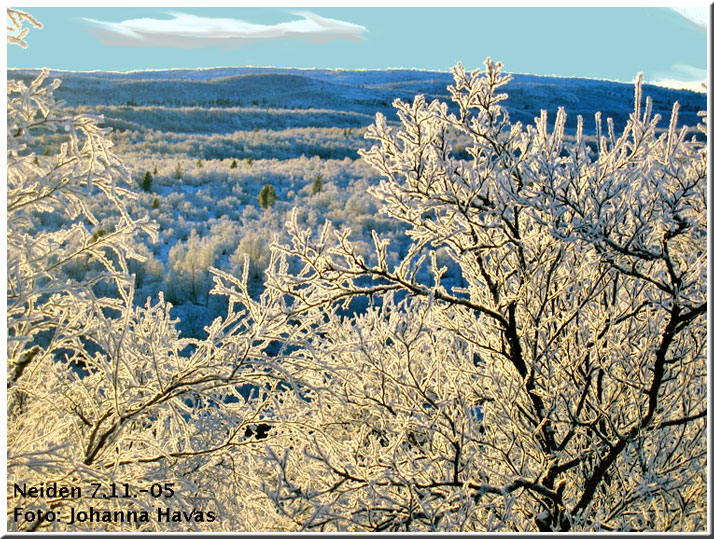
There are here and there big and old Scots pines (Pinus silvestris), that in wintertime jump out in the scenery.
This kind of outlook can see for instance in Saariselkä area. This picture is taken in Neiden (North Norway).
It seems unclear, the ecology and history of those pines. Are those relics from the warmer periods,
when pine was more common in the North? Or are the most pineforests collected to timber by Laplanders?
More: pine forest regions.
Some plants on the bare tops are so-called cushion plants, e.g. diapensia (Diapensia lapponica), creeping azalea (Loiseleuria procumbens) and purple saxifrage (Saxifraga oppositifolia) and moss campion (Silene acaulis): they have a thick, carpet-like growth to protect them from cold and desiccation. These species are often found on windswept locations (thin snow cover) and can tolerate temperatures as low as -50°C below zero in winter. Purple saxifrage is flowering few days after the snow has melted.
Mountain avens (Dryas octopetala) is a typical calciphilous mountain plant. Other calciphiles/chalk requiring species are e.g. Juncus biglumis, Viola biflora, Saxifraga tenuis, Salix polaris, Arnica angustifolia (arnica), Campanula uniflora and Pseudorchis albida (small white orchid). - Limestone areas are rare in Lapland.
Typical plants on the snow bed are e.g.: sibbaldia (Sibbaldia procumbens), cassiope (Cassiope hypnoides) and dwarf willow (Salix herbacea). On the bank of melting water brooks can meet buttercup (Ranunculus)- meadows.
Some fjeldplants, that benefit from limestone, are found in Finland even
in Kuusamo-area (southernmost occurrences), but in Norway anything in the southermost places.
This kind of plants have two concentration areas in the mountain range of the Keel of Norway (red balls in the map). See also:
bicentric plantoccurrences, refugiums and limestone areas on Lapland!
Yellow wood violet (Viola biflora), alpine sawworts (Saussurea alpina), alpine bartsia (Bartsia alpina)
and alpine meadow-rue (Thalictrum alpinum) not necessarily seek lime,
but moist, meadow-like habitat, for example brookfringes.